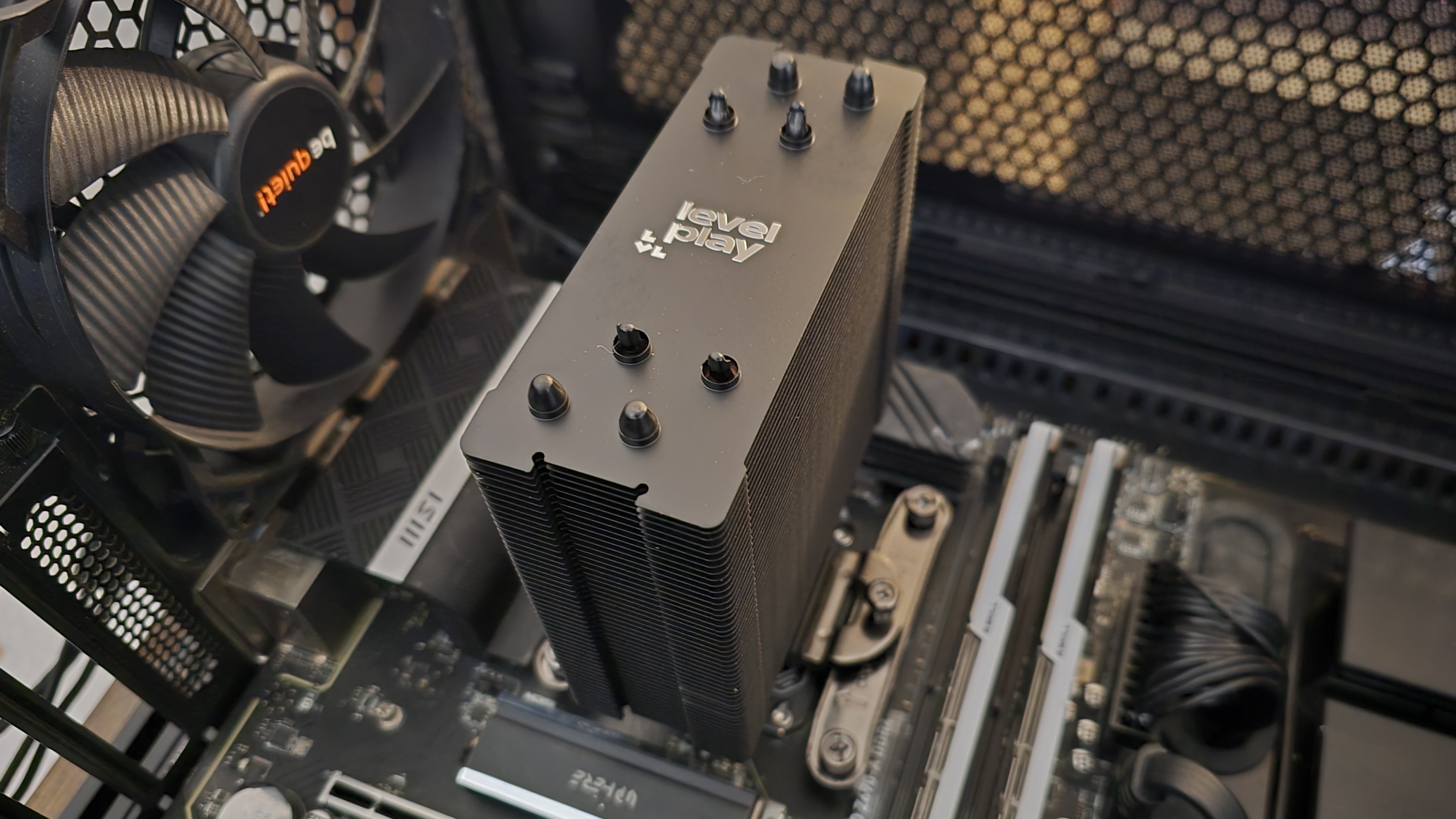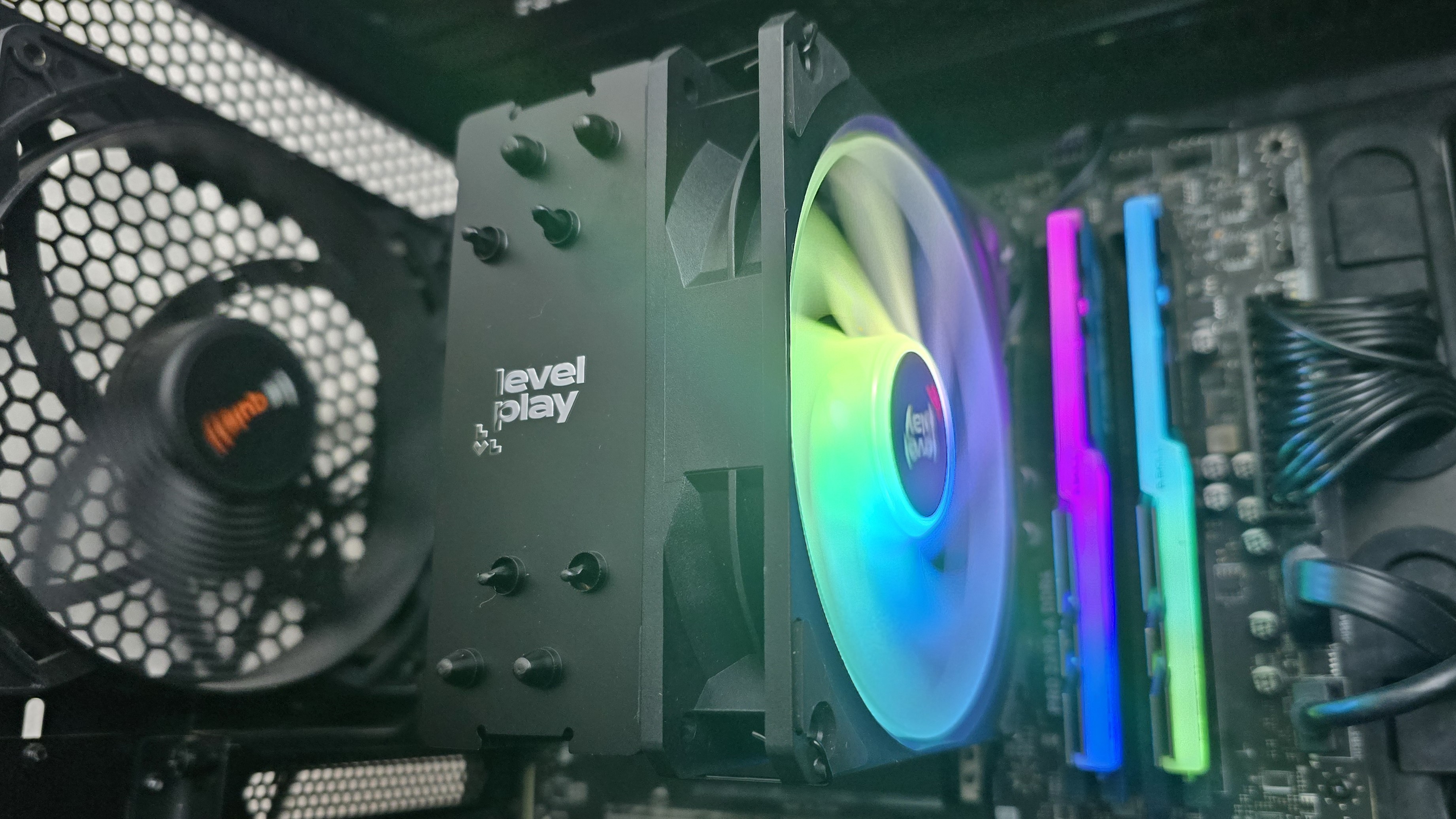Tom's Hardware Verdict
Levelplay’s Combat Air CA4 quietly delivers essential cooling performance for common tasks.
Pros
- +
Essential cooling performance for common tasks
- +
Low noise levels
- +
Reasonable $29.99 USD price
Cons
- -
No User manual
Why you can trust Tom's Hardware
The latest cooler to land on our test bench is from a new brand, LevelPlay, based out of Taiwan, that “encourages the freedom to be creative and playful in building powerful systems that express your style.” The company’s initial lineup includes the entry-level Combat Air CA4 CPU Cooler, CF120 ARGB fans, and the flagship Combat Liquid CL240 and CL360 AIOs.
While it’s nice to look at high-performance coolers that land on our best coolers list, it’s important to remember that most users only have moderate cooling needs. Today we’ll be covering LevelPlay’s entry-level cooling offering – the Combat Air CA4 Air Cooler. We’ll be testing it with Intel’s i7-13700K to determine if it provides the essential cooling performance needed in common scenarios like gaming.
| Cooler | Levelplay Combat Air CA4 CPU Cooler |
| Heatsink Material | Aluminum |
| Socket Compatibility | Intel Socket LGA 1851/1700 AMD AM5 / AM4 |
| Base | Direct Touch Heatpipes |
| Max TDP (Our Testing) | ~210W with Intel’s i7-13700K |
| Installed Size (with fans) | 121mm x 71 mm x 152mm |
| Warranty | $29.99 USD |
| MSRP | 3 Years |
Packing and included contents
The packaging of the air cooler is fairly compact, approximately twice the width of my cell phone. It is eye-catching with an orange-black aesthetic, in contrast to the dull and/or plain packaging that is used by some brands.
The inner contents are protected by cardboard, carefully packed to minimize wasted space.
Included with the cooler are the following:
- Single-tower heatsink radiator
- 1x 120mm cooling fan
- Mounting for AMD and Intel platforms
- Thermal paste
- Extra fan clips
Features of Levelplay’s Combat CA4 Air Cooler
• Full RAM compatibility
The Combat CA4 is a petite cooler, and doesn’t interfere or overhang RAM slots in any manner. As such, any size of RAM DIMMs, no matter how tall, are supported.
Get Tom's Hardware's best news and in-depth reviews, straight to your inbox.
• Single tower radiator
The Combat CA4 features a single tower radiator that’s designed for low resistance to airflow, to ensure the best possible thermal performance from the cooler.
• Four direct-touch copper heatpipes
Four direct-touch heatpipes move heat from the CPU into the fins of the heatsink.
• Small tube of thermal paste
There’s also a small tube of the company’s branded thermal paste in the box.
• 1x 120mm fan
I say this on almost every cooler review, but there’s more to a cooler than just the heatsink or radiator. The bundled fans have a significant impact on cooling and noise levels, as well as how the cooler looks in your case.
The included fan supports ARGB lighting and features outer walls to stabilize the fan blades and reduce vibrations.
| Model | Unlisted |
| Dimensions | 120 x 120 x 25mm |
| Fan Speed | 0-1800 RPM ± 10% |
| Air Flow | Unlisted |
| Air Pressure | Unlisted |
| Bearing Type | Unlisted |
| Lighting | ARGB |
| MFFT | Unlisted |
• Extra fan clips
If you want to push the cooler to its maximum potential, Levelplay includes an extra pair of fan clips that you can use to attach a second fan (not included).
What I don’t like about the Levelplay Combat Air CA4
• There is no manual!
The only real complaint I have about this cooler is that it lacks any kind of instruction manual, which can make things extremely confusing for novice users who might not be able to tell which parts are supposed to be used on Intel platforms and which should be used on AMD platforms.
If you’re reaching this page because you’re looking for those instructions, the next section will show you how to install the cooler.
Combat Air CA4 Cooler Installation
The biggest drawback of this product is its utter lack of a user manual. This section’s photos will cover how to install the cooler on Intel LGA 1700 and 1851 platforms, but I’ll also explain how to install the cooler on AMD AM4 and AM5 platforms.
1. Intel users will first need to apply the backplate to the rear of the motherboard. AMD users will remove the default cooler retention parts.
2. For Intel platforms, take the mounting studs featuring flat sides and secure them to the motherboard backplate. On AMD platforms you will instead use the mounting studs that are round and grooved and secure them against the motherboard.
3. Place the mounting bars atop of the studs, and secure them using the included thumbscrews. If you’re not sure which mounting bars to use, the AMD mounting bars are longer, and can only be installed in one direction. The Intel mounting bars are shorter, and can be installed horizontally or vertically.

4. Apply thermal paste to the CPU. If you’re unsure how to do that properly, check out our handy thermal paste application guide.
5. Remove the fan from the heatsink. Place the heatsink on top of the mounting bars, and secure it using a screwdriver.
6. Re-attach the fan to the heatsink using the fan clips.
7. Connect the PWM and ARGB headers to your motherboard, and power on your computer to complete installation.
Testing Methodology, and how my testing differs vs the competition
My cooler testing is specifically designed to emulate the conditions a user would actually experience when using a computer. Some reviewers test coolers using an open bench. I do not like this method, it reduces cooling difficulty. When you use a case, the internal temperature of that case will become higher than that of the room’s ambient temperature, increasing the saturation of the cooler and overall cooling difficulty. Testing outside of a case will give an advantage to weaker coolers, especially those with fans that aren’t very strong.
Others test using a thermal heatplate. This method suffers from all the drawbacks of an open bench, but also doesn’t accurately represent cooling a CPU. A thermal plate evenly distributes a thermal load across the copper heat conduction square. The problem with this type of testing is that modern AMD Ryzen and Intel Core CPUs have most of their heat concentrated in a few hotspots – and cooling a concentrated source of heat is more difficult than cooling a source that’s spread evenly.
The last thing I do differently than some cooler testers is that I insist on using relatively new CPUs for cooler testing because people building new PCs should be using recent CPUs. Also, thermal density is just different with newer CPUs. Products like Ryzen 3000 “Zen 2” and older 14nm Intel CPUs have lower heat density compared to modern counterparts, due to a combination of using older manufacturing processes and running at lower clock speeds. Using a weaker cooler with an older CPU can make the cooler look better performing than it actually is with current-gen silicon.
Today's highest-end CPUs, whether Intel or AMD, are difficult to cool in intensive workloads. In the past. reaching 95 degrees Celsius or more on a desktop CPU might have been a cause for concern. But with today’s top-end CPUs, this is considered normal operation. Similar behavior has been present in laptops for years due to cooling limitations in tight spaces.
All testing is performed with a 23 degrees C ambient room temperature. Multiple thermal tests are run on each CPU to test the cooler in a variety of conditions, and acoustic measurements are taken with each result. These tests include:
1. Noise-normalized testing at low noise levels
2. Out-of-the-box / Default configuration thermal and acoustic testing
a. No power limits enforced
b. Because CPUs hit TJ Max in this scenario, the best way to compare cooling strength is by recording the total CPU package power consumption.
3. Thermal and acoustic testing in power-limited scenarios
a. Power limited to 175W to emulate a medium-intensity workload
b. Power limited to 125W to emulate a low-intensity workload
The thermal results included are for 10-minute testing runs. To be sure that was sufficiently long to tax the cooler, we tested both Thermalright’s Assassin X 120 R SE and DeepCool’s LT720 with a 30-minute Cinebench test with Intel’s i9-13900K for both 10 minutes and 30 minutes. The results didn’t change much at all with the longer test: The average clock speeds maintained dropped by 29 MHz on DeepCool’s LT720 and 31 MHz on Thermalright’s Assassin X 120 R SE. That’s an incredibly small 0.6% difference in clock speeds maintained, a margin of error difference that tells us that the 10-minute tests are indeed long enough to properly test the coolers.
Testing configuration – Intel LGA1700 platform
LGA1700 Socket Bending
There are many factors other than the CPU cooler that can influence your cooling performance, including the case you use and the fans installed in it. A system's motherboard can also influence this, especially if it suffers from bending, which results in poor cooler contact with the CPU.
In order to prevent bending from impacting our cooling results, we’ve installed Thermalright’s LGA 1700 contact frame into our testing rig. If your motherboard is affected by bending, your thermal results will be worse than those shown below. Not all motherboards are affected equally by this issue. I tested Raptor Lake CPUs in two motherboards. And while one of them showed significant thermal improvements after installing Thermalright’s LGA1700 contact frame, the other motherboard showed no difference in temperatures whatsoever! Check out our review of the contact frame for more information.

Albert Thomas is a contributor for Tom’s Hardware, primarily covering CPU cooling reviews.











